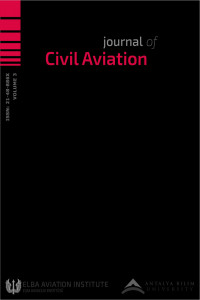Öz
Kaynakça
- O’Hare, D., Wiggins, M., Batt, R., and Morrison, D. (1994). Cognitive failure analysis for aircraft accident investigation. Ergonomics.
- Wiegmann, D. & Shappell, S. (1999). Human error and crew resource management failures in Naval aviation mishaps: A review of U.S. Naval Safety Center data, 1990-96. Aviation, Space, and Environmental Medicine.
- Yacavone, D. W. (1993). Mishap trends and cause factors in Naval aviation: A review of Naval Safety Center data, 1986-90. Aviation, Space and Environmental Medicine.
- International Air Transport Association (2019). Pilot Aptitude Testing Edition 3, Guidance Material and Best Practices.
- Wiegmann, D. & Shappell, S. (2001). A Human Error Analysis of Commercial Aviation Accidents Using the Human Factors Analysis and Classification System (HFACS)
- Beköz, A. B. & Beköz, Ü. & Çetinkaya, B. (2015) NOVA 1.01: A dynamic psychometric para-test for pilot candidates. The Journal of Civil Aviation.
- Fulkerson, S. C., Freud, S. L., & Raynor, G. H. (1958). The use of the MMPI in the psychological evaluation of pilots. Journal of Aviation Medicine. McKinley, J. C., Hathaway, S. R., & Meehl, P. E.
- (1948). The Minnesota Multiphasic Personality Inventory: VI. The K Scale. Journal of Consulting Psychology.
- Fleishman, E. A. (1956). Psychomotor selection tests: Research and application in the United States Air Force. Personnel Psychology. Shin, J. (2000). The NASA Aviation Safety Program: Overview.
- Stern, R. M., Koch, K. L. (1996). Motion Sickness and Differential Susceptibility. Current Directions in Psycolgical Science.
Öz
Among safety policies and protocols, which the civil aviation
authorities anticipate in order to achieve and maintain prior
involvement in monitoring and/or observing behavioral construction,
there is a fundamental action. The authority requires to know whether
a candidate has the base line capability of bearing and fulfilling the
requirements of the physical and mental pressures of the job on
student pilot candidate election programs. IATA’s pilot aptitude testing
need and guidance declares that the student pilot candidate election
programs should contain such parameters that a student pilot
candidate must succeed through (IATA,2019). We operated a test
protocol which was compatible with IATA’s demand of competence on
a student pilot candidate. With the predetermined success rates of
every test protocol battery, we provided results of the tests of spatial
attention, with regarding to the feedback from personality test, spatial
attention, spatial disorientation, perceptional focusing & memory,
spatial aptitude, decision making under stress, team work &
leadership. We analyzed the results of the tests and the spatial
attention sufficiency requirement has the least success rate in the
midst of basic abilities and sophisticated skills which a student pilot
candidate has to have. Among the 78 student pilot candidates, 38 pilot
candidates have failed from the pilot aptitude testing’s spatial
attention sufficiency parameter.
Anahtar Kelimeler
Kaynakça
- O’Hare, D., Wiggins, M., Batt, R., and Morrison, D. (1994). Cognitive failure analysis for aircraft accident investigation. Ergonomics.
- Wiegmann, D. & Shappell, S. (1999). Human error and crew resource management failures in Naval aviation mishaps: A review of U.S. Naval Safety Center data, 1990-96. Aviation, Space, and Environmental Medicine.
- Yacavone, D. W. (1993). Mishap trends and cause factors in Naval aviation: A review of Naval Safety Center data, 1986-90. Aviation, Space and Environmental Medicine.
- International Air Transport Association (2019). Pilot Aptitude Testing Edition 3, Guidance Material and Best Practices.
- Wiegmann, D. & Shappell, S. (2001). A Human Error Analysis of Commercial Aviation Accidents Using the Human Factors Analysis and Classification System (HFACS)
- Beköz, A. B. & Beköz, Ü. & Çetinkaya, B. (2015) NOVA 1.01: A dynamic psychometric para-test for pilot candidates. The Journal of Civil Aviation.
- Fulkerson, S. C., Freud, S. L., & Raynor, G. H. (1958). The use of the MMPI in the psychological evaluation of pilots. Journal of Aviation Medicine. McKinley, J. C., Hathaway, S. R., & Meehl, P. E.
- (1948). The Minnesota Multiphasic Personality Inventory: VI. The K Scale. Journal of Consulting Psychology.
- Fleishman, E. A. (1956). Psychomotor selection tests: Research and application in the United States Air Force. Personnel Psychology. Shin, J. (2000). The NASA Aviation Safety Program: Overview.
- Stern, R. M., Koch, K. L. (1996). Motion Sickness and Differential Susceptibility. Current Directions in Psycolgical Science.
Ayrıntılar
| Birincil Dil | İngilizce |
|---|---|
| Konular | Uzay Mühendisliği |
| Bölüm | Research Articles |
| Yazarlar | |
| Yayımlanma Tarihi | 7 Mart 2022 |
| Yayımlandığı Sayı | Yıl 2022 Cilt: 2 Sayı: 1 |


